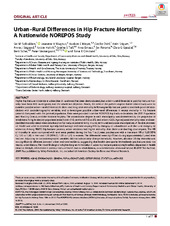| dc.contributor.author | Solbakken, Siri Marie | en_US |
| dc.contributor.author | Magnus, Jeanette H. | en_US |
| dc.contributor.author | Meyer, Haakon E | en_US |
| dc.contributor.author | Dahl, Cecilie | en_US |
| dc.contributor.author | Stigum, Hein | en_US |
| dc.contributor.author | Søgaard, Anne-Johanne | en_US |
| dc.contributor.author | Holvik, Kristin | en_US |
| dc.contributor.author | Tell, Grethe S. | en_US |
| dc.contributor.author | Emaus, Nina | en_US |
| dc.contributor.author | Forsmo, Siri | en_US |
| dc.contributor.author | Gjesdal, Clara Gram | en_US |
| dc.contributor.author | Schei, Berit | en_US |
| dc.contributor.author | Vestergaard, Peter | en_US |
| dc.contributor.author | Omsland, Tone Kristin | en_US |
| dc.date.accessioned | 2020-04-16T08:12:14Z | |
| dc.date.available | 2020-04-16T08:12:14Z | |
| dc.date.issued | 2019-09-09 | |
| dc.Published | Solbakken SM, Magnus JH, Meyer HE, Dahl C, Stigum H, Søgaard AJ, Holvik K, Tell GST, et al. Urban–Rural Differences in Hip Fracture Mortality: A Nationwide NOREPOS Study. JBMR Plus. 2019;3(11):e10236 | eng |
| dc.identifier.issn | 2473-4039 | |
| dc.identifier.uri | https://hdl.handle.net/1956/21890 | |
| dc.description.abstract | Higher hip fracture incidence in urban than in rural areas has been demonstrated, but urban–rural differences in posthip fracture mortality have been less investigated, and the results are disparate. Hence, the aims of the present register‐based cohort study were to examine possible urban–rural differences in short‐ and long‐term mortality in Norwegian hip fracture patients and their potential associations with sociodemographic variables, and to investigate possible urban–rural differences in excess mortality in hip fracture patients compared with the general population. Data were provided from the NOREPOS hip fracture database, the 2001 Population and Housing Census, and the National Registry. The urbanization degree in each municipality was determined by the proportion of inhabitants living in densely populated areas (rural: <1/3, semirural: 1/3 to 2/3, and urban: >2/3). Age‐adjusted mortality rates and standardized mortality ratios were calculated for hip fracture patients living in rural, semirural, and urban municipalities. A flexible parametric model was used to estimate age‐adjusted average and time‐varying HRs by category of urbanization with the rural category as reference. Among 96,693 hip fracture patients, urban residents had higher mortality than their rural‐dwelling counterparts. The HR of mortality in urban compared with rural areas peaked during the first 1 to 2 years postfracture with a maximum HR of 1.20 (95% CI, 1.10 to 1.30) in men and 1.15 (95% CI, 1.08 to 1.21) in women. The differences were significant during approximately 5 years after fracture. Adjusting for sociodemographic variables did not substantially change the results. However, absolute 30‐day mortality was not significantly different between urban and rural residents, suggesting that health‐care quality immediately postfracture does not vary by urbanization. The novel findings of a higher long‐term mortality in urban hip fracture patients might reflect disparities in health status or lifestyle, differences in posthip fracture health care or rehabilitation, or a combination of several factors. | en_US |
| dc.language.iso | eng | eng |
| dc.publisher | Wiley | eng |
| dc.rights | Attribution CC BY | eng |
| dc.rights.uri | http://creativecommons.org/licenses/by/4.0/ | eng |
| dc.subject | aging | eng |
| dc.subject | Epidemiology | eng |
| dc.subject | general population studies | eng |
| dc.subject | osteoporosis | eng |
| dc.subject | statistical methods | eng |
| dc.title | Urban–Rural Differences in Hip Fracture Mortality: A Nationwide NOREPOS Study | en_US |
| dc.type | Peer reviewed | |
| dc.type | Journal article | |
| dc.date.updated | 2020-01-13T15:46:19Z | |
| dc.description.version | publishedVersion | en_US |
| dc.rights.holder | Copyright 2019 The Author(s) | |
| dc.identifier.doi | https://doi.org/10.1002/jbm4.10236 | |
| dc.identifier.cristin | 1771795 | |
| dc.source.journal | JBMR Plus | |

